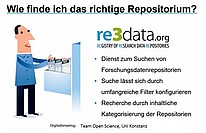Project phase
Services for editing and saving data
Personal disk space
Provider: KIM Hohenheim
The home directory on the Hohenheim file server provides space to save personal data for those with a Hohenheim user account. It is backed up daily.
Storage space: standard 2 GB, more upon request.
No costs for users
Further information
Cloud drive bwSync&Share
The state service bwSync&Share is an online storage service for employees and students of universities and colleges in Baden-Württemberg. This service enables users to synchronize or exchange their data among different computers, mobile devices, and users.
Further information
Storage space for teams (project directories CIFS)
Provider: KIM Hohenheim
In project directories on the file server, project teams can edit data together or put together individual websites for the projects. The back-up process is carried out daily. Storage space: standard 2 GB, larger project directory upon request.
No costs for users
Further information
Institute server
Provider: KIM Hohenheim
For institutes, KAM offers various services related to servers: Virtual servers, server housing, server procurement, server certificates.
Cost for users: Dependent on service.
Further information
Database service
Provider: KIM Hohenheim
Many web systems use databases as a substructure for saving their data. Upon request, KIM can set up a MySQL database for you and takes on the administration and maintenance of the database system.
Further information
High Performance Computing (bwHPC)
Provider: State wide Service. KIM Hohenheim as project partner
For scientists and students at the University of Hohenheim, the high-performance computers in Baden-Württemberg are available for data-intensive simulations and calculations. As part of the bwHPC project, KIM Hohenheim supports you in accessing and handling from the HPC system. The KIM also helps you to switch to an HPC cluster of the same level or a higher level. In addition, an extensive range of services is available, including document management, a bwHPC-Wiki, a training platform including elearning modules, a support system, and tiger teams.
No costs for users
Further information
SDS@hd
Provider: State wide service. KIM Hohenheim
The Scientific Data Storage (SDS@hd) is now available as a state service for university members. SDS@hd is meant for saving large amounts of scientific data up to terabytes / petabytes that are accessed regularly (“hot data”). There are no archiving possibilities. The data is saved on the storage system LSDF2 (second hardware generation at the Large Scale Data Facility).
Storage space: Currently no standard quota has been set. According to Heidelberg, the capacity is set up for terabytes/petabytes.
The use up to 100 TB per workgroup it free of charge. (Sept2023)
Cost for users: See the “price sheet” at SDS@hd Management - available for all bwIDM members after logging in with Shibboleth.
Finding data
There are various possibilities for finding others’ research data for a secondary analysis. An already well-known repository is one option to find suitable data, or through a journal article (e.g. in a data journal), or through special database search engines.
Special database search engines:
- DataONE Datenkatalog
- DataSearch by Elsevier
- Creative Commons CC Search
- re3data.org - Registry of research data repositories (the entries lead to department data centers that offer research data for secondary analysis.)
- Selection of data journals at the Humboldt University in Berlin (subject specific)
Citing data
The use of previous research data and publication of research findings require information about the author, location, and identification of the data.
Example of a complete citation for a resource:
Creator/Author (publication date): Title. Version. Publisher. General resource type. Identifier
,here the Identifier refers to the Digital Object Identifier (DOI). This is shown in the citation as a URL link including the necessary resolver and without “doi”. Resource type and version are optional.
Example: GESIS Panel Team (2014): GESIS Panel - Standard Edition. Version: 2.0.0. GESIS Datenarchiv. Dataset.
http://doi.org/10.4232/1.11947
More information can be found here (in German): Citing data
Metadata
Metadata is information that describes other data but does not include the data itself. Research data can only be found with well-documented metadata and can then be reused. In various scientific communities, metadata standards have been established for research data.
Examples of a dataset description:
- Which data was produced and how was it used?
- Is there a meta-standard preferred by the community?
- Definitions and methods used
- Data formats and units used
- Is the current format suited for archiving? Is it suitable for long-term access?
- How long does the data need to be stored?
- Were topics such as copyright and data protection considered?
- Literature / sources
- Spatial and temporal information about the samples
- Explicit variables and file names
More information can be found here (in German): Data organisation and Data documentation
Discipline-specific metadata standards (selection)
- Agricultural Sciences: Agricultural Metadata Element Set (AgMES)
- Biology: Ecological Metadata Language (EML), Genome Metadata, Biosharing standards
- Geosciences: ISO 19115, Darwin Core
- Natural Sciences: ICAT Schema, Cristallographic Information Framework
- Economic and Social Sciences: Digital Documentation Initiative (DDI)
Data formats
Proprietary data types such as .doc or .xls are usually not ideal for long-term data storage. That is why a version with open data format should be used for archiving.
Preferred file format options for archiving and long-term archiving:
- ODF, not Word
- ASCII, not Excel
- MPEG-4, not Quicktime
- TIFF or JPEG2000, not GIF or JPG
- XML or RDF, not RDBMS
You can find more information here (in German): Preserving formats
Do you have questions or comments about this site? contact form

